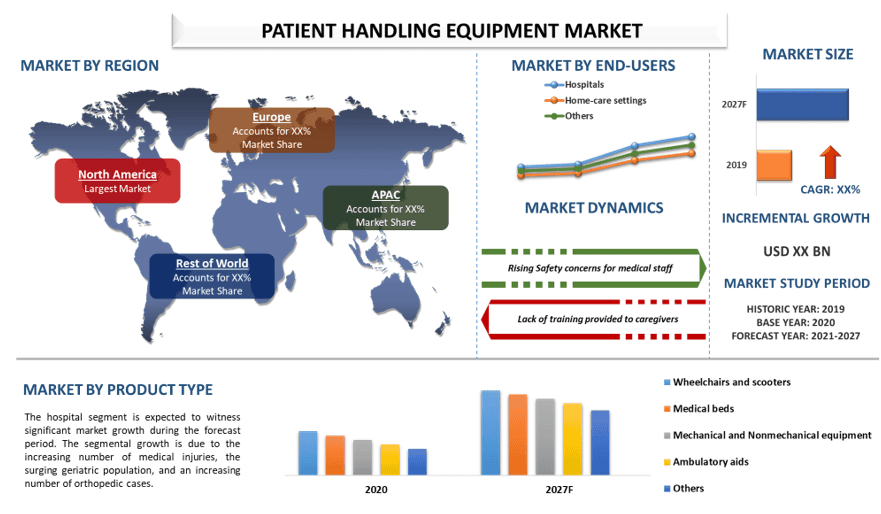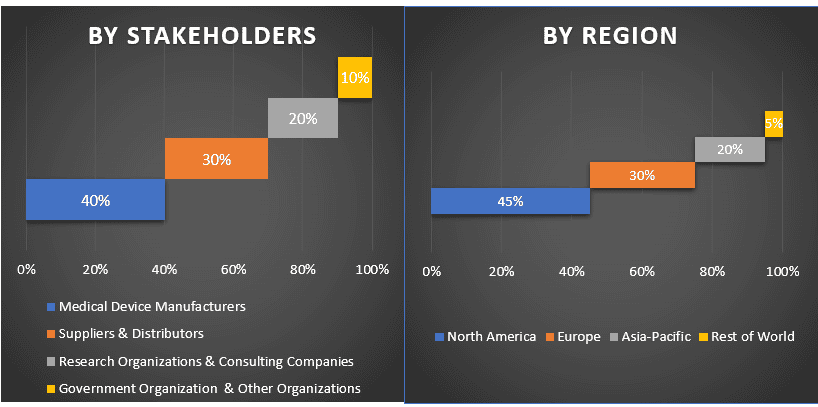- الرئيسية
- معلومات عنا
- صناعة
- الخدمات
- قراءة
- اتصل بنا
سوق معدات مناولة المرضى: التحليل الحالي والتوقعات (2021-2027)
التركيز على نوع المنتج (الكراسي المتحركة والسكوتر، والأسرة الطبية، والمعدات الميكانيكية وغير الميكانيكية، وأدوات مساعدة على المشي)؛ المستخدمون النهائيون (المستشفيات، وإعدادات الرعاية المنزلية، وغيرها)؛ المنطقة/البلد

من المتوقع أن ينمو سوق معدات مناولة المرضى العالمي بمعدل نمو سنوي مركب مرتفع يبلغ حوالي 6٪ خلال الفترة المتوقعة (2021-2027). تشتمل معدات مناولة المرضى على مجموعة واسعة من المنتجات الصحية المختلفة مثل الحمالات والكراسي المتحركة والأسرة المتحركة والكراسي القابلة للتعديل والمشايات وغيرها. هذه الأجهزة سهلة الاستخدام وتسمح للمرضى ومقدمي الرعاية بمراقبتها إلكترونيًا وتقليل خطر الإصابة.
إن التقدم السريع في التكنولوجيا وارتفاع عدد كبار السن بالإضافة إلى ارتفاع عدد الإعاقات الدائمة، يزيد من الطلب على مرافق رعاية صحية أفضل لإدارة عدد متزايد من الحالات. علاوة على ذلك، مع تزايد الوعي بين الفئة المستهدفة بشأن حلول المراقبة المنزلية، يركز العديد من اللاعبين في الصناعة على توسيع محفظتهم من خلال إطلاق خدمات ومنتجات جديدة في السوق، وبالتالي دعم نمو السوق. على سبيل المثال، في نوفمبر 2021، أعلنت شركة Able Innovations عن منصة ALTA الخاصة بها المصممة لمساعدة العاملين في مجال الرعاية الصحية على نقل المرضى بسهولة وكفاءة. تقوم منصة ALTA™ بأتمتة مهمة الرعاية الصحية الروتينية المتمثلة في نقل المرضى؛ نقل المريض بين الأسطح مثل السرير إلى النقالة، مما يساهم بشكل كبير في إرهاق العاملين في مجال الرعاية الصحية. علاوة على ذلك، يتزايد الطلب على معدات مناولة المرضى مع ارتفاع معدل انتشار العديد من الأمراض المزمنة في جميع أنحاء العالم.
Arjo و Hill-Rom Holdings Inc. و Invacare Corporation و Stryker و Drive divibliss healthcare, Inc. و ETAC AB و GF Health Products, Inc. و Guldmann, Inc. و Handicare group AB و Joerns Healthcare LLC، هي بعض من أبرز اللاعبين العاملين في سوق معدات مناولة المرضى. تم إجراء العديد من عمليات الاندماج والاستحواذ جنبًا إلى جنب مع الشراكات من قبل هؤلاء اللاعبين لتسهيل حصول العملاء على أنواع جديدة من أجهزة معدات مناولة المرضى.
رؤى مقدمة في التقرير
"من بين أنواع المنتجات، تستحوذ الكراسي المتحركة والدراجات البخارية على الحصة الأكبر"
استنادًا إلى نوع المنتج، يتم تقسيم سوق معدات مناولة المرضى إلى كراسي متحركة ودراجات بخارية وأسرّة طبية ومعدات ميكانيكية وغير ميكانيكية وأدوات مساعدة على المشي وغيرها. استحوذ قطاع الكراسي المتحركة والدراجات البخارية على حصة سوقية كبيرة في عام 2020، ويقدر أنه سيظهر معدل نمو سنوي مركب أعلى خلال الفترة المتوقعة. ويرجع نمو هذا القطاع بشكل أساسي إلى تزايد عدد الأمراض المزمنة على مستوى العالم. علاوة على ذلك، فإن الطلب على الكراسي المتحركة والدراجات البخارية في ازدياد بسبب تزايد عدد كبار السن وزيادة عدد المرضى الذين يعانون من اضطرابات دائمة.
"من بين المستخدمين النهائيين، يستحوذ قطاع المستشفيات على الحصة الأكبر"
استنادًا إلى المستخدمين النهائيين، ينقسم سوق معدات مناولة المرضى إلى المستشفيات وإعدادات الرعاية المنزلية وغيرها. استحوذت المستشفى على حصة سوقية كبيرة في عام 2020 ومن المتوقع أن تنمو بمعدل سريع في السنوات القادمة بسبب الزيادة السريعة في عدد كبار السن وارتفاع معدل انتشار الأمراض المزمنة المختلفة بينهم. على سبيل المثال، وفقًا لمنظمة الصحة العالمية، بين عامي 2015 و 2050، ستتضاعف تقريبًا نسبة سكان العالم الذين تزيد أعمارهم عن 60 عامًا من 12٪ إلى 22٪. أيضًا، سيكون 1 من كل 6 أشخاص في العالم يبلغون من العمر 60 عامًا أو أكثر بحلول عام 2030.
"تمثل منطقة آسيا والمحيط الهادئ واحدة من أكبر أسواق سوق معدات مناولة المرضى"
من أجل فهم أفضل لديناميكيات السوق لسوق معدات مناولة المرضى، تم إجراء تحليل مفصل لمناطق مختلفة في جميع أنحاء العالم بما في ذلك أمريكا الشمالية (الولايات المتحدة وكندا وبقية أمريكا الشمالية)، وأوروبا (ألمانيا وفرنسا وإسبانيا والمملكة المتحدة وإيطاليا وبقية أوروبا) وآسيا والمحيط الهادئ (الصين والهند وأستراليا واليابان وبقية منطقة آسيا والمحيط الهادئ)، وبقية العالم. خلال الفترة المتوقعة، من المتوقع أن تشهد منطقة آسيا والمحيط الهادئ نموًا كبيرًا في السوق العالمية. يمكن أن يعزى ذلك بشكل أساسي إلى زيادة الإنفاق على الرعاية الصحية لدول منطقة آسيا والمحيط الهادئ بالإضافة إلى وجود اقتصادات ناشئة في المنطقة مثل الصين والهند. على سبيل المثال، بلغ نصيب الفرد من الإنفاق على الرعاية الصحية في الصين 880 دولارًا أمريكيًا في عام 2019 والذي كان 658 دولارًا أمريكيًا في عام 2016. علاوة على ذلك، وجود لاعبين راسخين في السوق وإطلاق منتجات متكرر في المنطقة.
أسباب شراء هذا التقرير:
- تتضمن الدراسة تحليلًا لحجم السوق والتنبؤ به تم التحقق منه من قبل خبراء الصناعة الرئيسيين الموثوقين
- يقدم التقرير مراجعة سريعة للأداء العام للصناعة في لمحة
- يغطي التقرير تحليلاً متعمقًا لأقران الصناعة البارزين مع التركيز الأساسي على البيانات المالية الرئيسية للأعمال، ومحفظة المنتجات، واستراتيجيات التوسع، والتطورات الأخيرة
- دراسة تفصيلية للمحركات والقيود والاتجاهات الرئيسية والفرص السائدة في الصناعة
- تغطي الدراسة بشكل شامل السوق عبر قطاعات مختلفة
- تحليل متعمق على المستوى الإقليمي للصناعة
خيارات التخصيص:
يمكن تخصيص سوق معدات مناولة المرضى العالمي بشكل أكبر وفقًا للمتطلبات أو أي قطاع سوقي آخر. إلى جانب ذلك، تدرك UMI أن لديك احتياجات عمل خاصة بك، لذا لا تتردد في التواصل معنا للحصول على تقرير يناسب متطلباتك تمامًا.
جدول المحتويات
منهجية البحث لتحليل سوق معدات مناولة المرضى العالمي (2021-2027)
كان تحليل السوق التاريخي، وتقدير السوق الحالي، والتنبؤ بمستقبل سوق معدات مناولة المرضى العالمي هي الخطوات الرئيسية الثلاث التي تم اتخاذها لإنشاء وتحليل اعتماد معدات مناولة المرضى في المناطق الرئيسية على مستوى العالم. تم إجراء بحث ثانوي شامل لجمع أرقام السوق التاريخية وتقدير حجم السوق الحالي. ثانيًا، للتحقق من صحة هذه الرؤى، تم أخذ العديد من النتائج والافتراضات في الاعتبار. علاوة على ذلك، تم أيضًا إجراء مقابلات أولية شاملة مع خبراء الصناعة عبر سلسلة القيمة لسوق معدات مناولة المرضى العالمي. بعد افتراض والتحقق من صحة أرقام السوق من خلال المقابلات الأولية، استخدمنا نهجًا من أعلى إلى أسفل / من أسفل إلى أعلى للتنبؤ بحجم السوق الكامل. بعد ذلك، تم اعتماد طرق تقسيم السوق وتثليث البيانات لتقدير وتحليل حجم سوق القطاعات والقطاعات الفرعية للصناعة ذات الصلة. يتم شرح المنهجية التفصيلية أدناه:
اطلب المزيد من التفاصيل حول منهجية البحث
تحليل حجم السوق التاريخي
الخطوة 1: دراسة متعمقة للمصادر الثانوية:
تم إجراء دراسة ثانوية تفصيلية للحصول على حجم السوق التاريخي لمعدات مناولة المرضى من خلال مصادر الشركة الداخلية مثل التقرير السنوي والبيانات المالية، وعروض الأداء، والنشرات الصحفية، وما إلى ذلك، والمصادر الخارجية بما في ذلك المجلات والأخبار والمقالات والمنشورات الحكومية ومنشورات المنافسين وتقارير القطاعات وقاعدة بيانات الطرف الثالث والمنشورات الموثوقة الأخرى.
الخطوة 2: تقسيم السوق:
بعد الحصول على حجم السوق التاريخي لسوق معدات مناولة المرضى، أجرينا تحليلًا ثانويًا مفصلاً لجمع رؤى السوق التاريخية ومشاركتها للقطاعات والقطاعات الفرعية المختلفة للمناطق الرئيسية. تضمنت القطاعات الرئيسية المدرجة في التقرير نوع المنتج والمستخدمين النهائيين. تم إجراء المزيد من التحليلات على مستوى الدولة لتقييم الاعتماد الكلي لمعدات مناولة المرضى في جميع أنحاء العالم.
الخطوة 3: تحليل العوامل:
بعد الحصول على حجم السوق التاريخي للقطاعات والقطاعات الفرعية المختلفة، أجرينا تحليلًا للعوامل التفصيلية لتقدير حجم السوق الحالي لمعدات مناولة المرضى. علاوة على ذلك، أجرينا تحليلًا للعوامل باستخدام متغيرات تابعة ومستقلة مثل العدد المتزايد للأشخاص المصابين بأمراض مزمنة وتزايد عدد كبار السن في جميع أنحاء العالم. تم إجراء تحليل شامل لسيناريوهات جانب الطلب والعرض مع مراعاة الشراكات الكبرى وعمليات الاندماج والاستحواذ والتوسع التجاري وإطلاق المنتجات في قطاع معدات مناولة المرضى في جميع أنحاء العالم.
تقدير حجم السوق الحالي والتنبؤ به
تحديد حجم السوق الحالي: بناءً على رؤى قابلة للتنفيذ من الخطوات الثلاث المذكورة أعلاه، توصلنا إلى حجم السوق الحالي واللاعبين الرئيسيين في سوق معدات مناولة المرضى وحصص السوق للقطاعات. تم تحديد جميع حصص النسبة المئوية المطلوبة وتقسيمات السوق باستخدام النهج الثانوي المذكور أعلاه وتم التحقق منها من خلال المقابلات الأولية.
التقدير والتنبؤ: لتقدير السوق والتنبؤ به، تم تعيين أوزان لعوامل مختلفة بما في ذلك المحركات والاتجاهات والقيود والفرص المتاحة لأصحاب المصلحة. بعد تحليل هذه العوامل، تم تطبيق تقنيات التنبؤ ذات الصلة، أي النهج من أعلى إلى أسفل / من أسفل إلى أعلى، للوصول إلى توقعات السوق حول عام 2027 لقطاعات فرعية مختلفة عبر الأسواق الرئيسية على مستوى العالم. تشمل منهجية البحث المعتمدة لتقدير حجم السوق ما يلي:
- حجم سوق الصناعة، من حيث القيمة (بالدولار الأمريكي) ومعدل اعتماد معدات مناولة المرضى عبر الأسواق الرئيسية محليًا
- جميع الحصص المئوية وتقسيمات وتوزيعات القطاعات والقطاعات الفرعية في السوق
- اللاعبون الرئيسيون في سوق معدات مناولة المرضى من حيث المنتجات المعروضة. أيضًا، استراتيجيات النمو التي يتبناها هؤلاء اللاعبون للتنافس في السوق سريع النمو
التحقق من صحة حجم السوق وحصته
البحث الأولي: تم إجراء مقابلات متعمقة مع قادة الرأي الرئيسيين (KOLs) بما في ذلك كبار المسؤولين التنفيذيين (CXO/VPs، رئيس قسم المبيعات، رئيس قسم التسويق، الرئيس التنفيذي للعمليات، والرئيس الإقليمي، رئيس الدولة، إلخ) عبر المناطق الرئيسية. تم بعد ذلك تلخيص نتائج البحث الأولي وإجراء تحليل إحصائي لإثبات الفرضية المذكورة. تم دمج المدخلات من البحث الأولي مع النتائج الثانوية، وبالتالي تحويل المعلومات إلى رؤى قابلة للتنفيذ.
توزيع المشاركين الأساسيين في مناطق مختلفة

هندسة السوق
تم استخدام تقنية تثليث البيانات لإكمال تقدير السوق الإجمالي والوصول إلى أرقام إحصائية دقيقة لكل قطاع وقطاع فرعي من سوق معدات مناولة المرضى. تم تقسيم البيانات إلى عدة قطاعات وقطاعات فرعية بعد دراسة معايير واتجاهات مختلفة في مجالات نوع المنتج والمستخدمين النهائيين في سوق معدات مناولة المرضى.
الهدف الرئيسي من دراسة سوق معدات مناولة المرضى
تم تحديد اتجاهات السوق الحالية والمستقبلية لمعدات مناولة المرضى في الدراسة. يمكن للمستثمرين الحصول على رؤى استراتيجية لبناء تقديرهم للاستثمارات على التحليل النوعي والكمي الذي تم إجراؤه في الدراسة. حددت اتجاهات السوق الحالية والمستقبلية الجاذبية الكلية للسوق على المستوى الإقليمي، مما يوفر منصة للمشارك الصناعي لاستغلال السوق غير المستغلة للاستفادة كميزة المحرك الأول. تشمل الأهداف الكمية الأخرى للدراسات ما يلي:
- تحليل حجم السوق الحالي والمتوقع لمعدات مناولة المرضى من حيث القيمة (بالدولار الأمريكي). أيضًا، قم بتحليل حجم السوق الحالي والمتوقع للقطاعات والقطاعات الفرعية المختلفة
- تشمل القطاعات في الدراسة مجالات نوع المنتج والمستخدمين النهائيين
- تحديد وتحليل الإطار التنظيمي لصناعة معدات مناولة المرضى
- تحليل سلسلة القيمة المتضمنة مع وجود وسطاء مختلفين، جنبًا إلى جنب مع تحليل سلوكيات العملاء والمنافسين في الصناعة
- تحليل حجم السوق الحالي والمتوقع لسوق معدات مناولة المرضى في المنطقة الرئيسية
- تشمل المناطق الرئيسية التي تمت دراستها في التقرير أمريكا الشمالية وأوروبا وآسيا والمحيط الهادئ وبقية العالم
- الملفات التعريفية لشركات سوق معدات مناولة المرضى واستراتيجيات النمو التي يتبناها اللاعبون في السوق للاستمرار في السوق سريع النمو
- تحليل متعمق على المستوى الإقليمي للصناعة
ذات صلة التقارير
العملاء الذين اشتروا هذا المنتج اشتروا أيضًا










